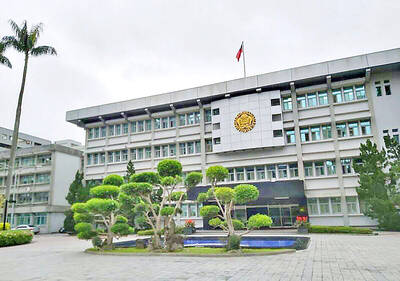Despite seemingly insurmountable obstacles, the government is determined to go ahead with its bid for UNESCO World Heritage status for traditional Chinese characters.
“Isn’t it amazing that elementary students in Taiwan can understand older, classical Chinese scripts, but children in [China] can’t?” Minister Without Portfolio Ovid Tzeng (曾志朗) asked.
Tzeng was assigned to lead a Cabinet-level task force on the mission.
Aside from Hong Kong and Macau, Taiwan is the only territory in the world where traditional Chinese characters, which by and large are the same as those used 3,000 years ago, are still in widespread use.
In 1956, China introduced simplified Chinese characters to improve literacy.
The simplifications undermined the six principles in character formation (六書) that traditional Chinese characters are constructed upon — pictographic representation, ideographic representation, ideographic compounding, phono-semantic compounding, metaphorical extension and phonetic loan — and lost their initial cultural connotations. Because of this it is difficult for people who learn simplified characters to understand ancient literature.
“Taiwan is probably the only place in the world where the wisdom of human progenitors is still preserved and where its people can have a dialogue with ancestors via the writing system currently in use. Egyptian hieroglyphs are no longer used, neither is Babylonian cuneiform writing,” Tzeng said.
Tasked by the Cabinet with launching the campaign, Tzeng said he would start by forming a team of officials, academics and private groups “to arouse world awareness that the traditional Chinese character system is worthy of protection” and “to endear the civilization to the world.”
“It’s not an easy job and it might take several years to accomplish, but it’s important,” Tzeng said.
The Cabinet set a four-year time frame in which to obtain UNESCO recognition.
Selena Wei (魏林梅), secretary-general of the Chinese Foundation for Digitization Technology, said that China would pose the biggest obstacle to the campaign.
“The campaign will not succeed without support from [China],” Wei said.
Wei said that the government “has to be extremely cautious in constructing its appeal so as not to provoke China,” as striving for international recognition for traditional Chinese characters “may somehow suggest that China was mistaken in abolishing the writing system and replacing it with simplified forms.”
“If we want to be successful, we have to make the campaign appear cooperative between Taiwan and the mainland in preserving the common assets of our ancestors, while downplaying the distinctions between traditional Chinese characters and simplified Chinese characters,” she said.
Tzeng did not share Wei’s concern over China’s possible objection to the campaign.
“I don’t see a reason for the mainland to oppose an initiative aimed at protecting the living wisdom that dates back 3,000 years,” Tzeng said.
“I don’t see the need to mention the history [of traditional characters being superceded by simplified scripts] in [China] in the campaign. That’s the mainland’s business, not ours,” he said.
Tzeng and Wei both agreed that the campaign should be pushed from a cultural perspective.
“It’s quite a natural thing that writing systems evolve. In [China’s] case, although it was an artificial factor that made its evolution happen in such a short time, there were actually no rules to this thing. If the evolution works out, new forms of writing exist. If not, it will turn around,” Tzeng said.
Wei said there has been a rising sentiment in academic and educational communities in recent years that China should revert to its previous writing system.
In contrast to such optimism, the preparatory office of the official Headquarters Administration of the Cultural Heritage Council, which conducted a feasibility assessment on the UNESCO bid, listed a number of practical difficulties for the campaign other than political factors pertaining to China.
The main obstacle to the campaign was that applicants have to be members of the UN and state parties of the Convention Concerning the Protection of World Cultural and Natural Heritage, said Wang Shou-lai (王壽來), director of the preparatory office.
Another concern was whether traditional Chinese characters meet the condition of “intangible cultural heritage in need of urgent safeguarding,” which defines such assets as ones “that are threatened by disappearance or marginalization as a result inter alia of conflicts, intolerance, excessive merchandizing, uncontrolled urbanization or rural decay,” the report said.
The definition was stipulated in the Istanbul Declaration proposed by the Third Round Table of Ministers of Culture of the UNESCO in September 2002, the report said.
Meanwhile, the procedures for registering intangible cultural heritages set by the UN in 2007 stipulate that applicant governments are required to draw up a set of comprehensive and feasible measures to protect and promote the heritage and take resolute action to implement the protection programs.

The German city of Hamburg on Oct. 14 named a bridge “Kaohsiung-Brucke” after the Taiwanese city of Kaohsiung. The footbridge, formerly known as F566, is to the east of the Speicherstadt, the world’s largest warehouse district, and connects the Dar-es-Salaam-Platz to the Brooktorpromenade near the Port of Hamburg on the Elbe River. Timo Fischer, a Free Democratic Party member of the Hamburg-Mitte District Assembly, in May last year proposed the name change with support from members of the Social Democratic Party and the Christian Democratic Union. Kaohsiung and Hamburg in 1999 inked a sister city agreement, but despite more than a quarter-century of

The Ministry of Foreign Affairs (MOFA) yesterday expressed “grave concerns” after Singaporean Prime Minister Lawrence Wong (黃循財) reiterated the city-state’s opposition to “Taiwanese independence” during a meeting with Chinese Premier Li Qiang (李強). In Singapore on Saturday, Wong and Li discussed cross-strait developments, the Singaporean Ministry of Foreign Affairs said in a statement. “Prime Minister Wong reiterated that Singapore has a clear and consistent ‘one China’ policy and is opposed to Taiwan independence,” it said. MOFA responded that it is an objective fact and a common understanding shared by many that the Republic of China (ROC) is an independent, sovereign nation, with world-leading

Temperatures in northern Taiwan are forecast to reach as high as 30°C today, as an ongoing northeasterly seasonal wind system weakens, the Central Weather Administration (CWA) said. CWA forecaster Tseng Chao-cheng (曾昭誠) said yesterday that with the seasonal wind system weakening, warmer easterly winds would boost the temperature today. Daytime temperatures in northern Taiwan and Yilan County are expected to range from 28°C to 30°C today, up about 3°C from yesterday, Tseng said. According to the CWA, temperature highs in central and southern Taiwan could stay stable. However, the weather is expected to turn cooler starting tonight as the northeasterly wind system strengthens again

The Ministry of Justice Investigation Bureau (MJIB) has been investigating nine shell companies working with Prince Holding Group, and the Taipei District Prosecutors’ Office is seeking further prosecution of alleged criminals, a source said yesterday. The nine companies and three Taiwanese nationals were named by the US Department of the Treasury’s Office of Foreign Assets Control (OFAC) on Oct. 14 as Specially Designated Nationals as a result of a US federal court indictment. Prince Holding founder Chen Zhi (陳志) has been charged with fraud, conspiracy, money laundering and overseeing Prince Holding’s suspected forced-labor camps in Cambodia, the indictment says. Intelligence shared between Taiwan,